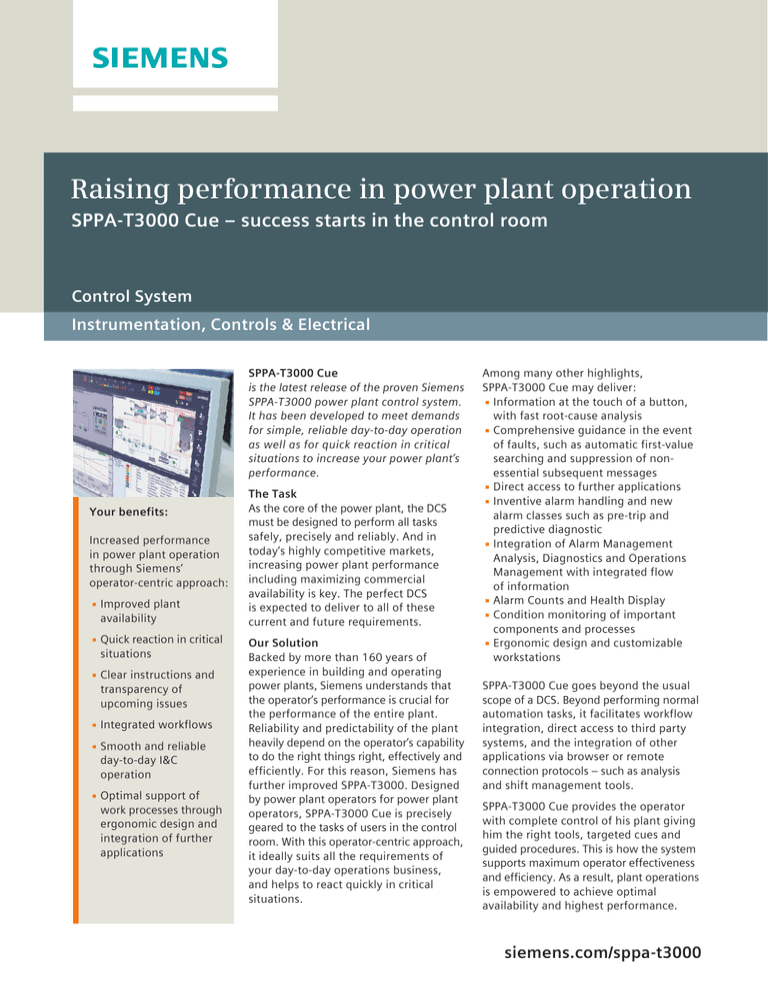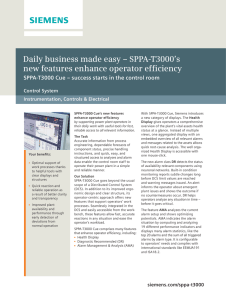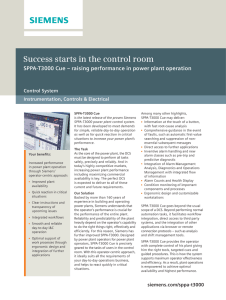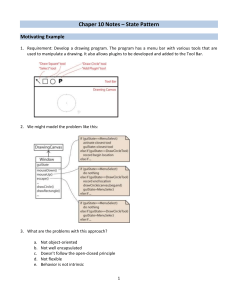
Raising performance in power plant operation
SPPA-T3000 Cue – success starts in the control room
Control System
Instrumentation, Controls & Electrical
SPPA-T3000 Cue
is the latest release of the proven Siemens
SPPA-T3000 power plant control system.
It has been developed to meet demands
for simple, reliable day-to-day operation
as well as for quick reaction in critical
situations to increase your power plant’s
performance.
Your benefits:
Increased performance
in power plant operation
through Siemens’
operator-centric approach:
▪▪Improved plant
availability
▪▪Quick reaction in critical
situations
▪▪Clear instructions and
transparency of
upcoming issues
▪▪Integrated workflows
▪▪Smooth and reliable
day-to-day I&C
operation
▪▪Optimal support of
work processes through
ergonomic design and
integration of further
applications
The Task
As the core of the power plant, the DCS
must be designed to perform all tasks
safely, precisely and reliably. And in
today’s highly competitive markets,
increasing power plant performance
including maximizing commercial
availability is key. The perfect DCS
is expected to deliver to all of these
current and future requirements.
Our Solution
Backed by more than 160 years of
experience in building and operating
power plants, Siemens understands that
the operator’s performance is crucial for
the performance of the entire plant.
Reliability and predictability of the plant
heavily depend on the operator’s capability
to do the right things right, effectively and
efficiently. For this reason, Siemens has
further improved SPPA-T3000. Designed
by power plant operators for power plant
operators, SPPA-T3000 Cue is precisely
geared to the tasks of users in the control
room. With this operator-centric approach,
it ideally suits all the requirements of
your day-to-day operations business,
and helps to react quickly in critical
situations.
Among many other highlights,
SPPA-T3000 Cue may deliver:
▪▪Information at the touch of a button,
with fast root-cause analysis
▪▪Comprehensive guidance in the event
of faults, such as automatic first-value
searching and suppression of nonessential subsequent messages
▪▪Direct access to further applications
▪▪Inventive alarm handling and new
alarm classes such as pre-trip and
predictive diagnostic
▪▪Integration of Alarm Management
Analysis, Diagnostics and Operations
Management with integrated flow
of information
▪▪Alarm Counts and Health Display
▪▪Condition monitoring of important
components and processes
▪▪Ergonomic design and customizable
workstations
SPPA-T3000 Cue goes beyond the usual
scope of a DCS. Beyond performing normal
automation tasks, it facilitates workflow
integration, direct access to third party
systems, and the integration of other
applications via browser or remote
connection protocols – such as analysis
and shift management tools.
SPPA-T3000 Cue provides the operator
with complete control of his plant giving
him the right tools, targeted cues and
guided procedures. This is how the system
supports maximum operator effectiveness
and efficiency. As a result, plant operations
is empowered to achieve optimal
availability and highest performance.
siemens.com/sppa-t3000
SPPA-T3000 Cue highlights
Key Performance Indicators (KPI)
are customizable in order to provide
optimum support to operators and
may include production data, output,
emissions values, trend reports on
pressures and temperatures, and
other values where needed.
Alarm Counts provide transparency
about the plant’s situation and allow
for quick and targeted reaction. Each
alarm class is shown with the numbers
of raising, unacknowledged and
pending alarms; double clicking opens
the alarm class-specific ASD.
“DR“ Diagnostic Recommended
is a new message class that detects
the status of availability-relevant
components by using model-based
condition monitoring. It then reports
subtle changes before DCS limit
values are reached.
Group Alarm Indicators reduce
reaction time in critical situations:
When an alarm is shown in a Plant
Display, it will be indicated in the Group
Alarm Indicator. By clicking the alarm
class of the Group Alarm Indicators,
the operator has direct access to the
corresponding Plant Display.
New alarm classes:
▪▪Trip Stop
▪▪Trip Warning
▪▪Diagnostic Recommended
Wake-up Alarms
Scroll-down Side bar
Buttons to own and
further applications
Ergonomic design
Clear displays
Integrated applications
e.g. Ergonomic buttons and icons
All icons in the control bar and in the
Faceplates are as large as possible so that
they can be easily recognized. Buttons for all
functions, including those in the library, are
clearly visible at all times to facilitate intuitive
and safe operation. And each operator can
tailor the control bar to his individual
requirements.
e.g. Health Display
This new category of displays gives the
operator a better focus by showing the health
status of vital components of the plant at a
glance. Well organized and accessible by only
one mouse click, the embedded overview on
all relevant alarms and messages related to
the component allows for quick root-cause
analysis.
e.g. “AMA“ Alarm Management & Analysis
AMA indicates the alarm situation and
displays all kind of alarm statistics, like the
top 20 alarms or the sum of all triggered
alarms by alarm type. It is configurable to
your needs. And AMA brings a clear view of
your conformity status relating to standards
like EEMUA191 or ISA18.2.
Published by and copyright © 2015:
Siemens AG
Power and Gas
Freyeslebenstrasse 1
91058 Erlangen, Germany
T3R72_FS_General_e_V1-0
Article No. PGIE-B10003-00-4A00
All rights reserved.
Trademarks mentioned in this document
are the property of Siemens AG, its affiliates,
or their respective owners.
For more information contact
sppa-t3000.energy@siemens.com
siemens.com/energy/sppa-t3000
Printed in Germany
Dispo 05401
Unrestricted
AL:N ECCN:N
Subject to change without prior notice.
The information in this document contains
general descriptions of the technical options
available, which may not apply in all cases.
The required technical options should
therefore be specified in the contract.







